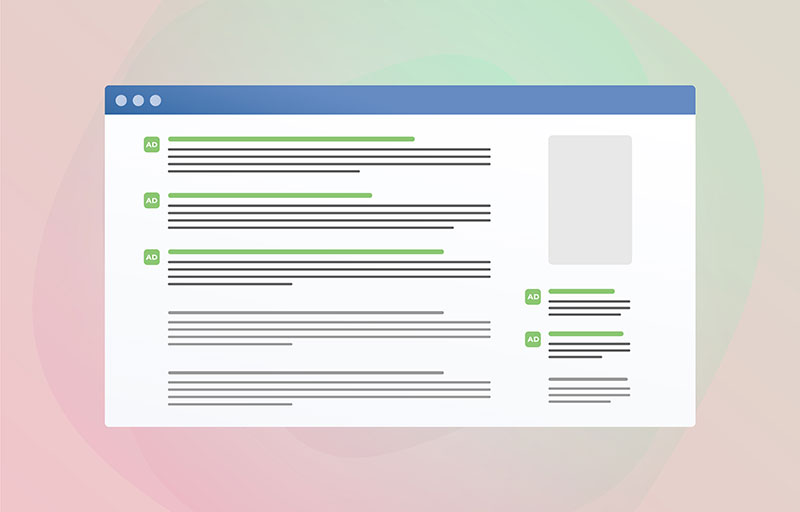How Paid Ads Work in Digital Marketing
Paid ads are part of the digital marketing strategy of many companies for one simple reason: they deliver results.
Important for anyone who wants to spread their brand faster, see everything you need to know about paid ads and how to use them to bring visibility to your business.

Why invest in paid ads?
There is a saying in digital marketing that goes like this: “The best place to hide a dead body is on the second page of a Google search”. A little over the top? Certainly, but there is still some truth to it.
According to Search Engine Journal, results on page 2 of a Google search have a click-through rate (CTR) of less than 1%.
What do we learn from this? If you want to get to the top fast, paid ads are the solution.
Of course, with content production and periodic updates to your site, you can beat the competition and earn your spot among the first page results, but that takes time.
If you want to grow your audience and sell your product/service faster, you will need to invest in paid ads, while creating content to increase your traffic organically.
Doing this through tools like Google Ads, for example, can be quite costly, but the good news is that paid ads can also be done on other platforms, such as the various social networks.
– 8 digital marketing tips to sell more
How do paid ads work?
In the more traditional form of paid advertising, companies and professionals create their ads on the platform they want to advertise, paying a predetermined amount each time someone clicks or views their ads in a search result.
In Google Ads, sponsored ads occupy the top of the first page of results.
On social media platforms, they can appear in different positions depending on which channel you are using.
In search engines, paid ads appear according to the keyword you have defined and the term searched by the user. On social networks, they appear according to the segmentation rules you specified.
The possibilities for segmentation are numerous, and the less money you have to invest, the more interesting it is to funnel the number of people your advertising appears to, only spending it on who is actually a potential lead.
Digital platforms have several ways to divide audiences based on factors such as:
- Demographic information (age, gender, income, geography, family size, etc.);
- Subscriptions;
- Purchases;
- Online behavior, etc.
Different platforms have different parameters, so having buyer personas well-defined can help you spend less time and money on trial and error.
– How to create buyer personas for my business
Clicks vs. Impressions
There are two main ways platforms charge for their ads.
One is by the number of impressions, i.e. how many people viewed your ad. Every time it appears in a search, it counts as an impression, even if the person seeing it doesn’t click on it.
The other way to pay is on an action basis. When a user clicks on your ad, you are charged, hence the name “cost per click” (CPC) or “pay per click” (PPC).
Bottom line:
- Impressions means you pay for visibility.
- CPC means you pay for engagement.
Those who opt for the impression strategy are usually more focused on branding. Those who opt for CPC ads focus on driving traffic to their sales page, to get the user to take an action.
Paid Ads Types

There are many different types of paid ads you can create for lead generation or brand awareness.
We’ve listed some of the most common categories and quickly explained how to use each one.
Search Engine Advertising
When you do a search on platforms such as Google, Yahoo and Bing, the search engines on these platforms evaluate which sites offer the best answer to what you are looking for, listing them in order of relevance.
Paid ads appear at the top of this list, however, consider that countless companies are creating ads that target the same audience, so what guarantees that yours will appear there, in the few available positions?
Several factors influence this, but basically it works like an auction. When creating an ad, you must define a keyword, which can be more or less competitive, and say how much you pay each time someone searches for it and your ad appears. Whoever pays more, will have greater visibility.
However, money is not a unanimous factor here. Your ad has to “please” Google in several other ways that make up what it calls its Quality Score.
A high Quality Score can cause your ads to appear in a higher position than competitors who bid higher but have lower scores.
The goal of Google and other search engines is to offer the best answer to what the user is looking for.
If your ad was shown little, but got a high click-through rate, it will consequently be shown more often, because the platform will understand that it is useful to the user.
How to advertise on Google Ads
Google is the most visited platform in the world, so it’s the first one that companies turn to to advertise their products/services.
To advertise on Google, just go to ads.google.com and create your account. If you already have an account that is used on Google services such as Gmail, you can use this one.
If this is your first time creating paid ads, choose the beginner option. You won’t have many configuration options, but at least you’ll get your ads live faster and without much hassle.
Choose a group of keywords related to the product/service you want to advertise, create an ad by filling in the fields that will appear and define the website where these ads will be directed.
Creating an ad with high converting power is not the simplest of tasks and you will have to study and delve deeper into the features of Google Ads, as well as learn about copywriting.
Also, it’s important to keep in mind that the cost of using Google Ads can vary significantly. Understanding Google ads pricing is crucial to ensure you get the best return on your investment, especially with bid strategies and keyword optimization impacting costs differently across industries.
– Practical guide to SEO and Copywriting for online sales
It is best to create more than one ad and do performance tests to see which one brings the best result. But all this will depend on how much you have to invest.
Mastering the tool can take some time, so keep in mind that you can lose money before you start earning.
Social Media Advertising
Most social media platforms offer the ability to create and run paid advertisements on its pages.
The most used currently are Facebook, Instagram, YouTube, LinkedIn and Twitter.
Social media pay per click differs from search ads in that instead of targeting users based on keywords, you are targeting users based on interests.
More mature platforms like Facebook and Instagram have audience targeting tools that offer multiple options based on user data.
As with search engines, social media ads are charged per CPC or impression. However, much simpler and cheaper to use to create and run paid ads than Google, social networks are a great option for advertising for those who are starting and don’t have a lot of money.
To make it even easier, Facebook owns Instagram and you can advertise on both with the same setup.
LinkedIn has increasingly become an interesting B2B channel to advertise, but is typically a more expensive investment.
Twitter advertising includes promoted tweets, promoted accounts, and promoted trends, and each of these options has its own table of values.
The cost of promoted tweets can range from less than a dollar to a few dollars per share. Promoted accounts cost a few dollars for each follow-up. Promoted trends can cost up to hundreds of thousands of dollars a day.
Depending on the niche you are in and the audience you want to reach, one social network may be better than the other for serving your paid ads. In general, the following is advised:
- B2B Channels: Facebook, Instagram and LinkedIn
- B2C Channels: Facebook, Instagram and Twitter
These are the networks that present the best sales and engagement results at the moment, but always be aware of what is new.
Platforms like SnapChat and TikTok, depending on your audience, can also be good options.
– How to use social media to sell online courses
Youtube
Technically, Youtube can be considered a social media and, with the high engagement power of videos nowadays, it deserves special attention. In addition, of course, to the platform being the second most accessed website in the world.
Since Google took over YouTube, they have gone to great lengths to make paid ads on the platform as simple and customizable to create as they are on AdWords. The possibilities are numerous:
- Skippable In-Stream Video Ads: These can run before or during a video. They play for a minimum of 5 seconds and then the viewer has the option to ignore them. One of the great things about this type of ad is that you’re only charged when someone watches at least 30 seconds, the entire ad (for any ad under 30 seconds), or clicks on it.
- Non-skippable in-stream video ads: These ads can also be played right before or during a video, the only difference being that there is no skip button. Charges are per impression, more specifically, per 1,000 views (CPM).
- Bumper Ads: Skippable video ads that play immediately before a video. These ads are quite effective and perfect for anyone who has a simple message to get across.
- Discovery Ads: These are very similar to Google search ads, appearing among search results in a semi-organic way. Discovery ads consist of a thumbnail image and three lines of text. They can be displayed on the search results page, video watch page and YouTube homepage, which gives them a lot of visibility.
- Non-Video Ads: For brands that don’t want to spend a lot, this is a good option. You can choose to run an image ad (banner) on the right side of the results while a video is playing. Additionally, you can serve a banner ad overlay that appears during a video from a channel that has decided to monetize. They are paid using the CPC method.
– 14 Strategies to get more YouTube views
Now that you know the best platforms to run paid ads, it’s time to promote your business with full force.
Online course producers can rely on Coursify.me to host and promote their courses.
Optimized for SEO and with perfect integration with the main social networks and content platforms, with Coursify.me you are already halfway in the work of positioning yourself well in search engines and attracting customers.
To learn more, visit our website, test the platform and see how easy it is to profit doing what you love.

